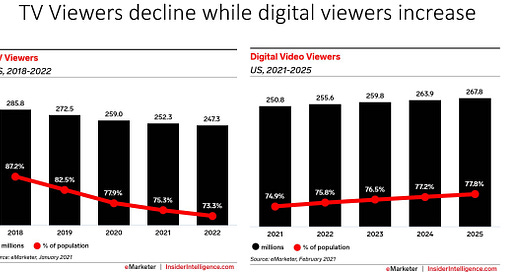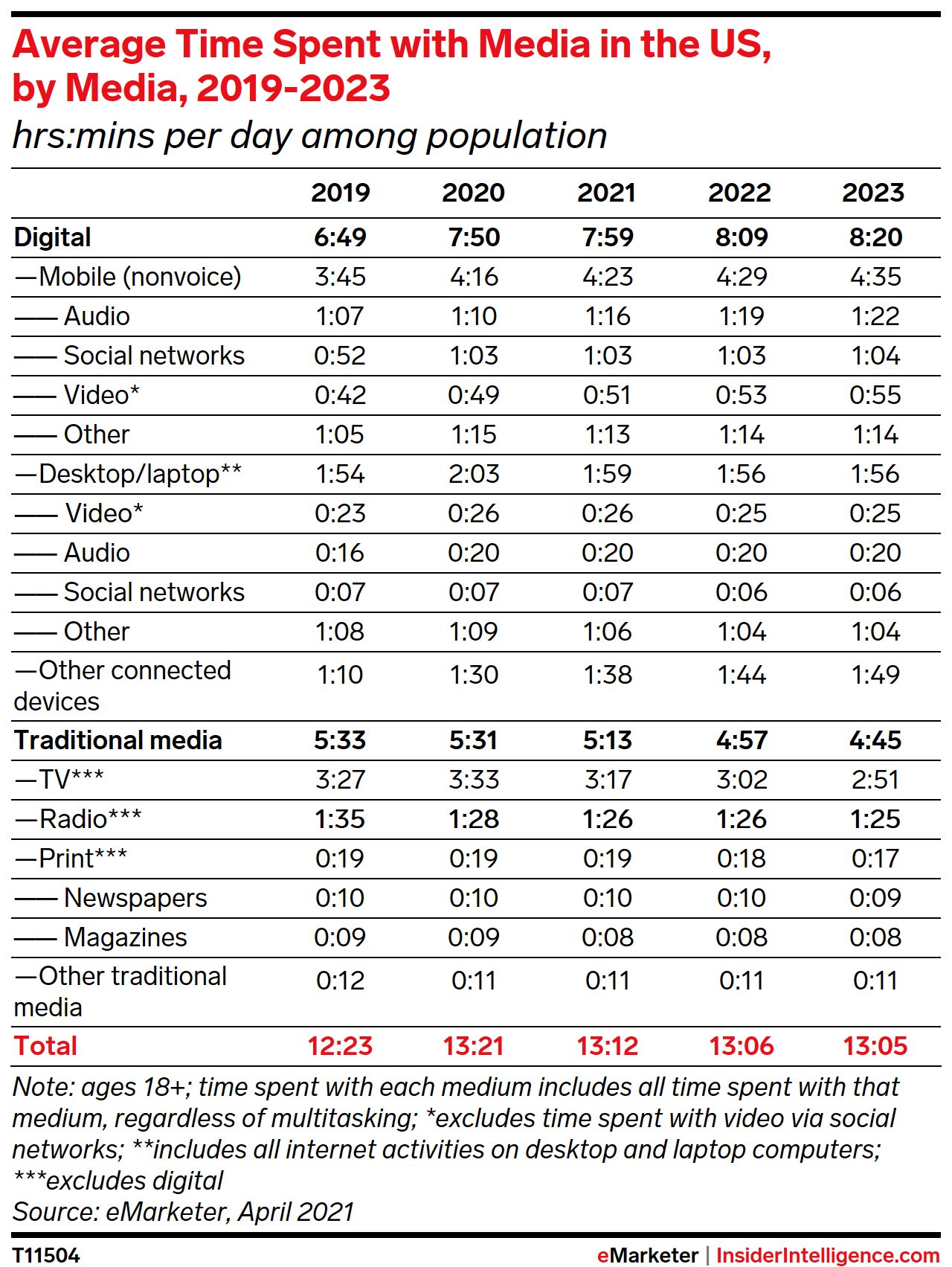Three Things for June 10, 2021
This week: How will time spent with media change in the next few years? Plus, micro-disruptions as a way to innovate and "social giving."
Welcome to the June 10th edition of the Three Things newsletter for public media leaders from the Public Impact Group. Here's what's up this week:
How will time spent with media change in the next few years?
Micro-disruptions as a way to innovate
Social Giving: It’s growing and reaching young and diverse donors
THING ONE: Where are audiences going with media usage?
eMarketer is one of the most valuable sources available for consumer research, and last week we learned about projections for media use in the US through 2023. While I’m a believer in always looking forward, the data from 2020 is worth noting because it brought about such a significant change in how people used media during the year of the pandemic.
In 2020, the estimated average daily time spent with all media increased by almost an hour (58 minutes) to a new high of 13 hours, 21 minutes (13:21). Most of the time spent growth last year was with digital media, which increased by more than an hour a day with mobile devices and “other connected devices”1 leading the way.
What makes 2020 such a fascinating year is that most traditional media usage remained steady in the year of COVID as well. The bad news is that radio was the only type of traditional media usage to see a drop during the year as people spent less time in cars commuting to and from work. This is not unexpected since Nielsen Audio data throughout the year also reflected these trends.
Digital audio usage over mobile devices (most likely phones) increased by 4% to one hour, 10 minutes per day, while broadcast radio dropped by about 7% to one hour, 28 minutes per day. Daily listening to digital audio via computers clocked in at 20 minutes a day, a four-minute YoY increase.
The data gets very interesting when you review the projections from 2021 through 2023.
The Winners: Mobile audio and other connected devices.
The Losers: Broadcast (or Traditional) TV and Social networks
After the significant drop from 2019 to 2020, time spent with broadcast radio is projected to remain relatively steady through 2023.
The Strategic Implications
Radio isn’t dead … yet. The research projects a 10% drop in time spent listening from 2019 through 2023, but most of that loss occurred last year. However, we know through various studies that younger audiences are listening significantly less to broadcast radio than baby boomers. If you’re looking to reach a younger audience, radio will not be the way to do it.
Overall digital audio listening2 has now surpassed broadcast radio. I’ll repeat: overall digital audio listening has now surpassed broadcast radio. By looking at the trends through 2023, it’s vital to commit your strategies to serve audiences via mobile devices and smart speakers. A comprehensive content and marketing approach will be necessary if you’re looking to grow your audience since your competition is not necessarily other radio stations in the market.
In Kurt Hansen’s RAIN News, Brad Hill writes that “this study can be somewhat beside the point. When you consider the largest traditional radio companies own some portion of digital audio listening via their podcast holdings (notably NPR, iHeartMedia, and Audacy), those traditional brands enjoy some of the time spent (and audience reach) that belongs in the digital category.” That may be true for iHeart and Audacy. However, the federated structure of public radio means that the incredible success that NPR has in the podcasting space has not necessarily trickled down to member stations.
The drop in time spent viewing traditional TV could also have implications for public radio since many of our organizations are joint licensees. The projected decrease of more than 40 minutes a day by 2023 is enormous. The chart from another eMarketer research study shows the trend to digital video viewership in the coming years. The trends for audio and video point to the need for organizations to be fully focused on how to best reach listeners and viewers on digital platforms.
The final takeaway is the prediction that time spent with social networks will be flat in the next three years. After a big increase from 2019 to 2020 (most likely due to the surge in the use of TikTok), eMarketer is projecting that usage will be flat through 2023. This was a surprise to me. Given the time and attention that media organizations spend on social media strategies, this information may cause a rethink of our efforts around social.
THING TWO: Champion the concept of micro-disruptions
As noted in Thing One, the pace of audiences moving from traditional to digital media seems to be increasing faster, which, in turn, creates more urgency to address these shifts in media usage. A few weeks ago, I shared the concept of Engine 1 | Engine 23 that The Bridgespan Group proposed to bring innovation to the nonprofit sector.
Another model to bring innovation is encouraging staff to develop micro-disruptions as part of your ongoing organizational strategy.
A micro-disruption is a deceptively small change to institutional processes, products, or services that have outsized and long-term implications. The beauty of a micro-disruption is that businesses do not need to overhaul their entire business model to address the nascent, disruptive, and long-lasting shifts in consumer behavior. They simply need to build on compelling consumer insights and integrate with already existing systems and products.
Kate Watts, CEO of the branding firm Long-Dash4, recently wrote about this concept in a blog post on the company’s website. In the post Think Small to Go Big, she offers some ideas on how high performing organizations are using micro-disruptions to operate more effectively:
They learn to move fast. Look for small ways to save time, reduce friction, and create efficiencies focused on better service for your listener or reader. Perhaps it’s adjusting a portion of the micro-formatics of your on-air sound, tweaking the design of your mobile app, or possibly making minor changes in the workflow in your newsroom to allow you to post newscasts or stories more quickly to your website. All of these may provide opportunities to provide a better experience for your audience. Watts suggests that leaders “select experiments and implementations that are small-scale and well-resourced so that quality solutions can be put into the market quickly.”
They make data a hallmark of their culture. Explore how the wealth of information you have about your audience and your donors can be used to provide a better experience for them. Watts makes the critical point that this also “promotes a culture where customer data is readily available across teams and viewed as the driving force for innovation.”
They form micro-disruption teams—or MDTs for short. These are small teams5 made up of people across the organization empowered by leadership to test their micro-disruptions unencumbered by distractions. Leadership needs to prioritize these teams by providing them with adequate time and resources while advancing a collaborative culture.
What I like most about this concept for public media is that it requires an Audience First approach focusing on constant feedback and engagement with your audience. In addition, it forces an organization to maintain discipline and focus on key success metrics to assess whether the mico-disruptions are hitting the mark.
THING THREE: How are you engaging prospective donors with Social Giving?
Public media’s connection to donors has not been severely impacted by the social distancing restrictions we’ve experienced over the past 15 months. Still, for the nonprofit sector as a whole, this has been a significant challenge to overcome. Many have focused on new and innovative ways to engage potential supporters through various virtual fundraising activities and events.
For public media, we can learn from the experiences of these other nonprofits as an added tool in our revenue-generating toolkit for the future.
That’s why I found a research study on Social Giving conducted this spring by Edge Research valuable in examining this unique type of donor. We’ll describe this group as Social Donors, defined as anyone who self-reports giving to at least one charitable organization by attending a fundraising event; participating or sponsoring someone in a fundraising activity like a run, walk or ride; or donating or requesting donations for and occasion, challenge, or giving month or day within in the last 12 months.
First, this type of philanthropy is growing. Approximately 27% of U.S. adults self-identify as a Social Donor, up from 23% in 2018. The area that appeals best for public media is the rise of giving days (think Giving Tuesday). The research study showed that giving days work particularly well in appealing to younger donors and people of color.
The other key point is that the “ease of giving” was the top motivating factor for giving, followed by supporting the mission and the impact that a gift can make for the organization. The “ease of giving” focus provides me with the opportunity to go on a bit of a rant encouraging station leaders to look at the donation page on your station’s website with your smartphone (not on your desktop computer).
NextGeneration Fundraising recently posted a Donation Form Do’s and Don’ts list on its website with excellent suggestions to improve the donor experience. A couple of basics:
DO Default to Monthly Gifts
DO Optimize for Mobile Devices (this is a place where a lot of stations could do better and is growing in importance as detailed in Thing One)
DON’T Get Too Personal (get the info you need but don’t overload a prospective donor with too many questions)
A donation form is a place where there are proven best practices so use the KISS method for the greatest success.
Thanks for reading.
“Other connected devices” would include streaming video to your television and Smart Speaker use, which we know were big winners in 2020.
Overall digital audio listening includes listening through mobile devices, desktop computers, and Smart Speakers.
Earlier this week, The Bridgespan Group hosted a webinar discussing the Engine 1 | Engine 2 concept. You can view it here.
Long Dash, formerly known as Atlantic 57, is a creative consultancy that brings a journalistic approach to its work.
The objectives of MDTs are: 1) Identify consumer challenges through user data—in particular, rapid, small sample qualitative research can unlock powerful insights, 2) Concept low-lift changes that will have high impact, 3) Implement with laser focus – resist the desire to go bigger, and 4) Analyze results and iterate.





